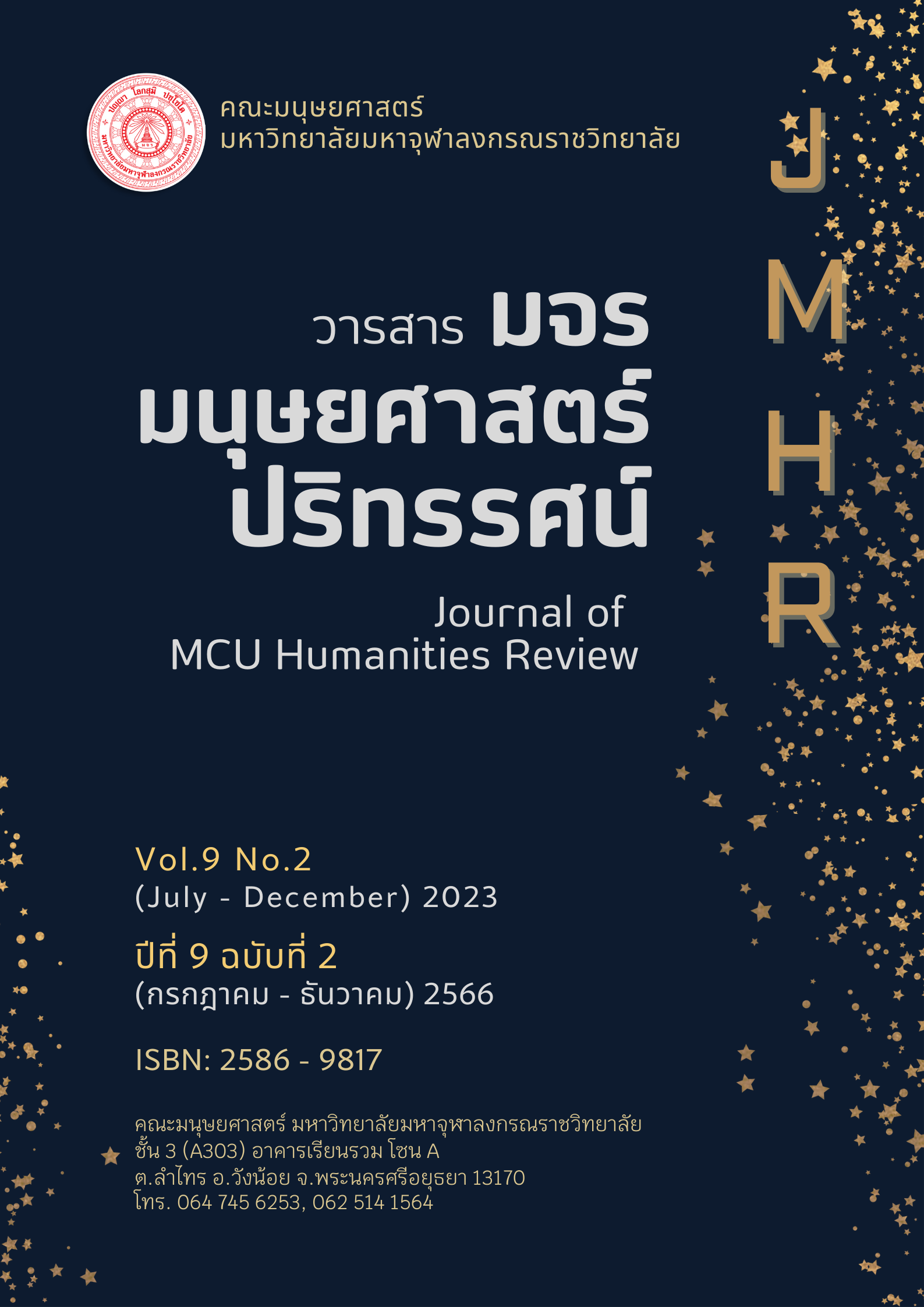หลักพุทธจิตวิทยาส่งเสริมพลังใจให้เยาวชนมองเห็นคุณค่าแท้ในชีวิตของตนเองและสังคม
คำสำคัญ:
พุทธจิตวิทยา, การเสริมสร้างพลังใจ, เด็ก, เยาวชน, คุณค่าชีวิตบทคัดย่อ
สังคมปัจจุบันต่างมีการแข่งขันความเจริญก้าวหน้าในด้านวัตถุนิยมต่าง ๆ แต่ขาดทางด้านคติธรรม คือ หลักในการดำเนินชีวิตเกี่ยวข้องกับคุณธรรมจริยธรรม เช่น ความซื่อสัตย์ เมตตา กรุณา กตัญญูกตเวที ทำให้มนุษย์มีความสุขสบายทางกายแต่กลับมีปัญหาด้านจิตใจ สังคมยิ่งพัฒนาแต่จิตใจมนุษย์ยิ่งมีปัญหา เห็นได้ว่าเยาวชนยุคปัจจุบัน วิ่งตามกระแสโลกทางเทคโนโลยีมากเกินไป จนลืมฐานรากของธรรมชาติเดิม หลักพุทธจิตวิทยาจึงเป็นองค์ความรู้ ที่จะทำให้เยาวชนทุกคนเข้าใจชัดเจนถึงกระบวนการทำงานของธรรมชาติจิต จึงจำเป็นอย่างยิ่งที่จะต้องทําให้เยาวชน สามารถเข้าใจและตระหนักถึงพลังใจของตนเองทางพุทธจิตวิทยา ในสิ่งต่างๆรอบตัว เพื่อที่จะไม่หลงยึดติดกับค่านิยมที่ผิด ๆ หรือฟังข่าวสารหรือเสพข่าวที่เป็นเท็จ ๆ และยังสามารถดํารงชีวิตได้อย่างมีความสุข การมีพลังใจที่เข้มแข็งเป็นส่วนสําคัญ เปรียบเหมือนการมีภูมิคุ้มกันที่ดี ที่จะช่วยให้เยาวชนรุ่นใหม่ สามารถปรับตัวเมื่อเผชิญกับสถานการณ์ต่าง ๆ ได้เป็นอย่างดี และมีความสามารถในการแก้ปัญหามองเห็นปัญหา พลังใจทั้งภายในและภายนอก โดยมีหลักพุทธจิตวิทยาหรือพุทธธรรมนำมาเสริมสร้างพลังใจ เช่น พละ 5 กัลยาณมิตธรรม ซึ่งทั้งสองหลักธรรมเป็นพื้นฐานจะทำให้เข้าใจเหตุผล มีหลักในการดำเนินชีวิตไปในทางที่ถูกต้องดีงาม มีคุณภาพชีวิตที่ดีต่อไป
เอกสารอ้างอิง
กมลาศ ภูวชนาธิพงศ์. (2563). ผลการใช้กิจกรรมการพัฒนาตนเพื่อเสริมสร้างสุขชีวีวิถีพุทธสำหรับเยาวชนในศูนย์การเรียนรู้พระพุทธศาสนาและการพัฒนาสังคมวัดสุทธิวราราม. วารสารสังคมศาสตร์และมานุษยวิทยาเชิงพุทธ, 5(3), 41.
กรมสุขภาพจิต. (2563). แนวทางการดูแลสุขภาวะด้านจิตใจ (พิมพ์ครั้งที่ 1). กรุงเทพฯ: บียอนด์ พับลิสชิ่ง.
จิรกิตต์ภรณ พิริยสุวัฒน์. (2019). จิตวิทยาในพระไตรปิฎก (พิมพ์ครั้งที่ 3). เลย: บ้านนาอ้อ.
ชมพูนุท ศรีจันทร์นิล. (2552). จิตวิทยาแนวพุทธ : แนวทางเพื่อการเยียวยาและพัฒนาจิตใจมนุษย์. วารสารวิชาการมหาวิทยาลัยหอการค้าไทย, 29(4), 188-208.
ปริญญา ชะอินวงษ์. 2563). การถูรังแกผ่านโลกไซเบอร์และความเสี่ยงต่อการฆ่าตัวตายในเยาวชน. วารสารการพยาบาลจิตเวชและสุขภาพจิต, 34(3), 133.
พระธรรมกิตติวงศ์ (ทองดี สุรเตโช). (2551). พจนานุกรมเพื่อการศึกษาพุทธศาสน์ (พิมพ์ครั้งที่ 3). กรุงเทพฯ :ธรรมสภาและสถาบันบันลือธรรม.
พระธรรมมงคลญาณ (พระอาจารย์ วิริยังค์ สิรินธโร). (2556). โยนิโสมนสิการ วิธีคิดตามหลักพุทธธรรม (พิมพ์ครั้งที่ 24). ฉบับข้อมูลคอมพิวเตอร์.
พระพรหมคุณาภรณ์ (ป.อ.ปยุตฺโต). (2559). พจนานุกรมพุทธศาสน์ ฉบับประมวลศัพท์ (ชำระ-เพิ่มเติม ช่วงที่ 1) (พิมพ์ครั้งที่ 27). กรุงเทพฯ : โรงพิมพ์มหาจุฬาลงกรณราชวิทยาลัย.
“_________”. (2563). พุทธธรรม (ฉบับปรับขยาย) (พิมพ์ครั้งที่ 54). กรุงเทพฯ: ผลิธัมม์.
“_________”. (2556). โยนิโสมนสิการ วิธีคิดตามหลักพุทธธรรม (พิมพ์ครั้งที่ 24). ฉบับข้อมูลคอมพิวเตอร์.
พระมหาวุฒิชัย วชิรเมธี. (2553). 7 สิ่งมหัศจรรย์ของชีวิต 7 หลักคิดเพื่อความสุข. กรุงเทพฯ: สถาบันวิมุตตยาลัย.
ยุทธนา พูนเกิดมะเริง และ พระสิทธิศักดิ์ พรมสิทธิ์. (2563). กัลยาณมิตรกับการพัฒนาคุณภาพชีวิตตามแนวทางพระพุทธศาสนา. วารสารมหาจุฬานาครทรรศน์, 7(10), 197-208.
รายงานสุขภาพคนไทย. (2563). ภาวะซึมเศร้าของเด็กและเยาวชน:จะช่วยอย่างไร?. นครปฐม: มหาวิทยาลัยมหิดล.
เริงชัย หมื่นชนะ.(2558). ระบบและทฤษฎีพุทธจิตวิทยา. วารสารมหาจุฬาวิชาการ, 2(1), 62-79
สมเด็จพระพุทธโฆษาจารย์ (ป.อ. ปยุตฺโต), 2562). จากจิตวิทยา สู่จิตภาวนา (พิมพ์ครั้งที่ 19). กรุงเทพฯ: มหาจุฬาลงกรณราชวิทยาลัย ในพระบรมราชูปถัมภ์.
สุเทพ ชิตยวงษ์. (2562). เด็กมีปัญหาสุขภาพจิตเยอะ สพฐ. ตื่นตัว จัดระบบดูแลจิตใจในโรงเรียนอย่างจริงจัง หลังพบตัวเลขเด็กโทร.ปรึกษาสายด่วนสุขภาพจิตอื้อ. สืบค้น 22 มกราคม 2566, จาก https://shorturl.asia/6NEpS
อัญมณี มณีนิล. (2563). ปัจจัยที่มีอิทธิพลต่อภาวะซึมเศร้าของวัยรุ่นตอนปลาย (วิทยานิพนธ์พยาบาลศาสตรมหาบัณฑิต). มหาวิทยาลัยบูรพา. ชลบุรี.
Coopersmith,S. (1981). The antecedents of self-esteem. Palo Alto. CA: Consulting Psychologists Press.
Grotberg H.E. (2005). Resilience for Tomorrow. International Council of Psychologists Convention.Brazil: Iguazu.
Ngamchat, A. (2013). Buddhist psychology in the Tripitaka (1st ed.). Bangkok: Phimsuay.
Wolin, JS & Wolin, S. (2010). The Resilient Self: How Survivors of Troubled Families Rise above Adversity. New York: Random House Digital, Inc.
Angela Duckworth. (2016). Grit: The Power of passion and Perseverance. New York: An Imprint of Simon & Schuster Inc.
Jean Carpenter-Williams. (2017). Youth ThriveM. Promoting Youth Resilience. Washington, D.C: The center for the Study of Social Policy.
ดาวน์โหลด
เผยแพร่แล้ว
รูปแบบการอ้างอิง
ฉบับ
ประเภทบทความ
หมวดหมู่
สัญญาอนุญาต
ลิขสิทธิ์ (c) 2023 วารสาร มจร มนุษยศาสตร์ปริทรรศน์

อนุญาตภายใต้เงื่อนไข Creative Commons Attribution-NonCommercial-NoDerivatives 4.0 International License.






